Dog Collars for Large Breed: Complete Guide to Choosing the Right Collar in 2025
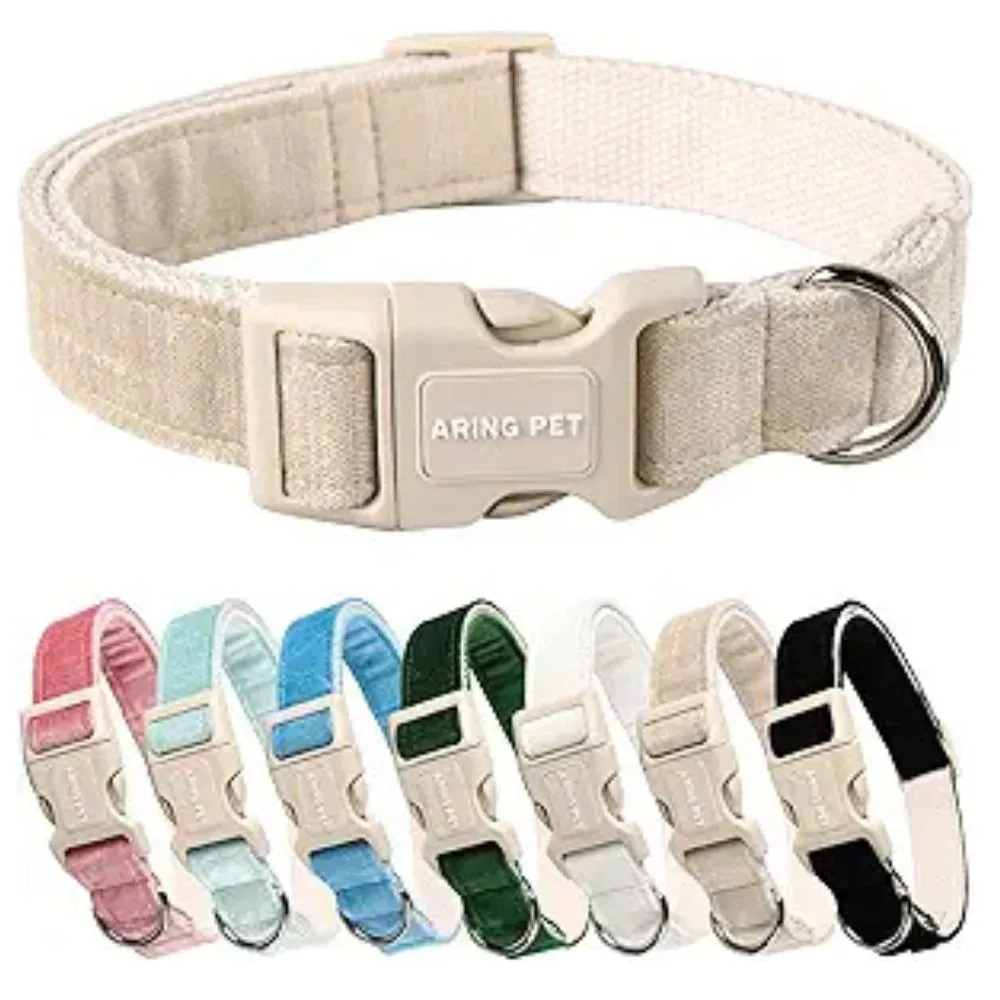
Choosing the right collar for your large dog isn’t just about finding something that fits—it’s about ensuring their safety, comfort, and well-being while addressing specific behavioral or training needs. Whether you have a gentle giant like a Great Dane or an energetic Labrador, this comprehensive guide will help you select the perfect collar for your big furry friend.
Why Large Dogs Need Special Consideration for Collars
Large dogs require collars specifically designed to handle their size, strength, and unique anatomical needs. A collar that works perfectly for a Chihuahua simply won’t provide the durability, width, or control necessary for a 70-pound Rottweiler or 100-pound Mastiff.
Large breed dogs exert significantly more pulling force during walks, making collar strength and construction critical safety factors. Additionally, their broader necks need wider collars to distribute pressure evenly, preventing injury to their trachea and cervical spine. The wrong collar can cause serious health issues, from breathing difficulties to neck injuries, making informed selection essential.
Types of Dog Collars for Large Dogs
Understanding the different collar types available helps you match your dog’s specific needs with the right solution.
Everyday Flat Collars
Standard flat collars serve as the foundation for most large dogs’ collar wardrobe. These collars hold identification tags and provide a leash attachment point for well-behaved dogs who walk calmly.
For large dogs, look for collars that are:
- At least 1 to 1.5 inches wide to distribute pressure and prevent tracheal damage
- Made from heavy-duty materials like thick leather or reinforced nylon that won’t snap under pressure
- Equipped with metal buckles or heavy-duty quick-release clasps rated for your dog’s weight and strength
- Featuring rust-resistant hardware such as stainless steel or brass D-rings
Quality everyday collars for large breeds should feel substantial in your hands and show excellent stitching with no loose threads or weak points.
Martingale Collars
Martingale collars offer gentle control for large dogs who tend to back out of regular collars. These limited-slip designs tighten slightly when your dog pulls but can’t choke them like old-fashioned choke chains.
They’re particularly valuable for large breeds with narrow heads relative to their neck size, such as:
- Greyhounds and other sighthounds
- Doberman Pinschers
- Great Danes
- Whippets
The martingale provides security without harsh corrections, making it ideal for leash training large dogs who haven’t quite mastered loose-leash walking.
Training Collars for Large Dogs
When working on obedience and behavioral issues, specialized training collars for large dogs can be effective tools when used correctly and humanely.
Prong Collars (Pinch Collars)
Despite their intimidating appearance, properly fitted prong collars distribute pressure evenly around the neck, mimicking the correction a mother dog gives puppies. For very strong large dogs who pull dangerously, prong collars can provide control while you work on training.
Critical considerations:
- Must fit correctly—sitting high on the neck just behind the ears
- Should never be left on unsupervised
- Require proper instruction to use humanely
- Work best as temporary training aids, not permanent solutions
Head Halters
Head halters like the Gentle Leader control your large dog’s movement by gently guiding their head. When your dog’s head turns, their body follows, giving you significant control over even the strongest pullers without putting pressure on their neck.
These are excellent alternatives to traditional training collars, especially for large dogs with:
- Tracheal sensitivity
- Respiratory issues common in large breeds
- Extreme pulling behavior
- Owners who prefer positive reinforcement methods
Remote Training Collars
Electronic training collars remain controversial but can be effective for off-leash training with large dogs in open areas. Modern versions offer vibration and tone options alongside stimulation, providing multiple communication methods.
If considering electronic training collars for large dogs:
- Consult a professional trainer for proper introduction
- Start with the lowest effective setting
- Never use for punishment—only for communication
- Ensure the collar is specifically rated for large breed neck sizes and coat types
Bark Collar for Large Dogs
Excessive barking can be challenging with large dogs whose deep, loud voices carry significant distances. A bark collar for large dogs addresses nuisance barking through various correction methods.
Types of Bark Collars:
Citronella Spray Collars: Release a burst of citronella scent when barking is detected. These offer humane correction that most dogs find unpleasant enough to deter barking. They work well for large dogs who bark at triggers like mailmen or squirrels.
Vibration Bark Collars: Provide a vibrating sensation when your dog barks. These are gentler than other options and work well for dogs who are sensitive to physical sensations.
Static Bark Collars: Deliver mild static correction when barking occurs. Modern barking collar for large dogs options feature adjustable intensity levels, ensuring you can find the minimum effective correction for your specific dog.
Ultrasonic Bark Collars: Emit high-frequency sounds inaudible to humans but unpleasant to dogs. Effectiveness varies significantly between individual dogs.
When selecting bark collars for your large breed, ensure:
- The collar’s sensor can accurately detect deep, low-frequency barking typical of large dogs
- Sensitivity settings prevent false triggers from external noises
- The collar’s size and contact points fit properly against your dog’s neck through their coat
- Battery life suits your usage needs
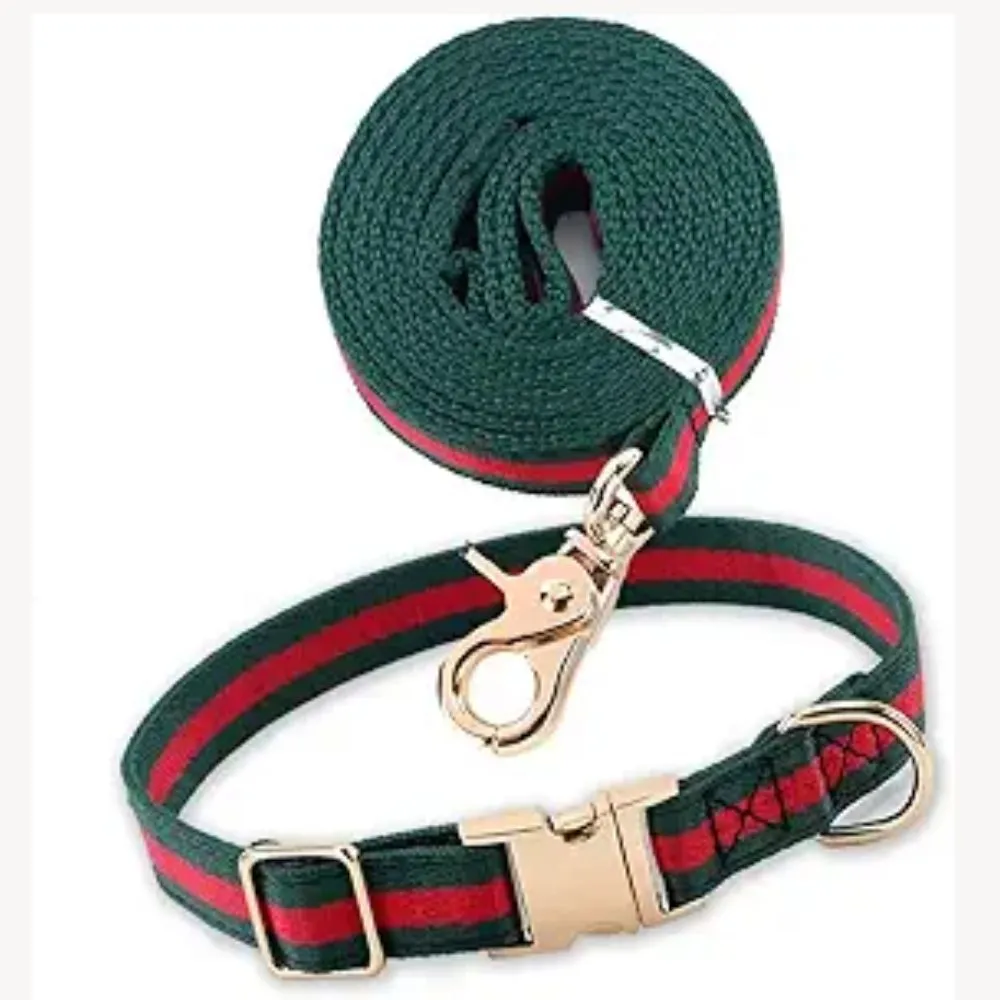
Best Elizabethan Collar for Large Dogs
After surgery or during wound healing, the best elizabethan collar for large dogs prevents your pet from licking, biting, or scratching affected areas while remaining as comfortable as possible.
Traditional Plastic E-Collars
The classic cone design works reliably but can be cumbersome for large dogs navigating doorways and furniture. Look for:
- Extra-large sizes that extend beyond your dog’s nose when they crane their neck
- Padded edges that won’t rub or chafe
- Clear plastic options that maintain some peripheral vision
- Easy-to-clean smooth surfaces
Soft Recovery Collars
Inflatable donut-style collars or padded fabric alternatives offer more comfort for large dogs who need extended recovery periods. These allow your dog to eat, drink, and rest more naturally while still preventing them from reaching wounds.
Benefits include:
- More comfortable for sleeping
- Less disruption to household navigation
- Better acceptance from anxious dogs
- Suitable for neck and upper body wound protection
Surgical Recovery Suits
For torso wounds or spay/neuter recovery, full-body suits eliminate the need for Elizabethan collars entirely while protecting surgical sites. These work particularly well for large female dogs after spaying.
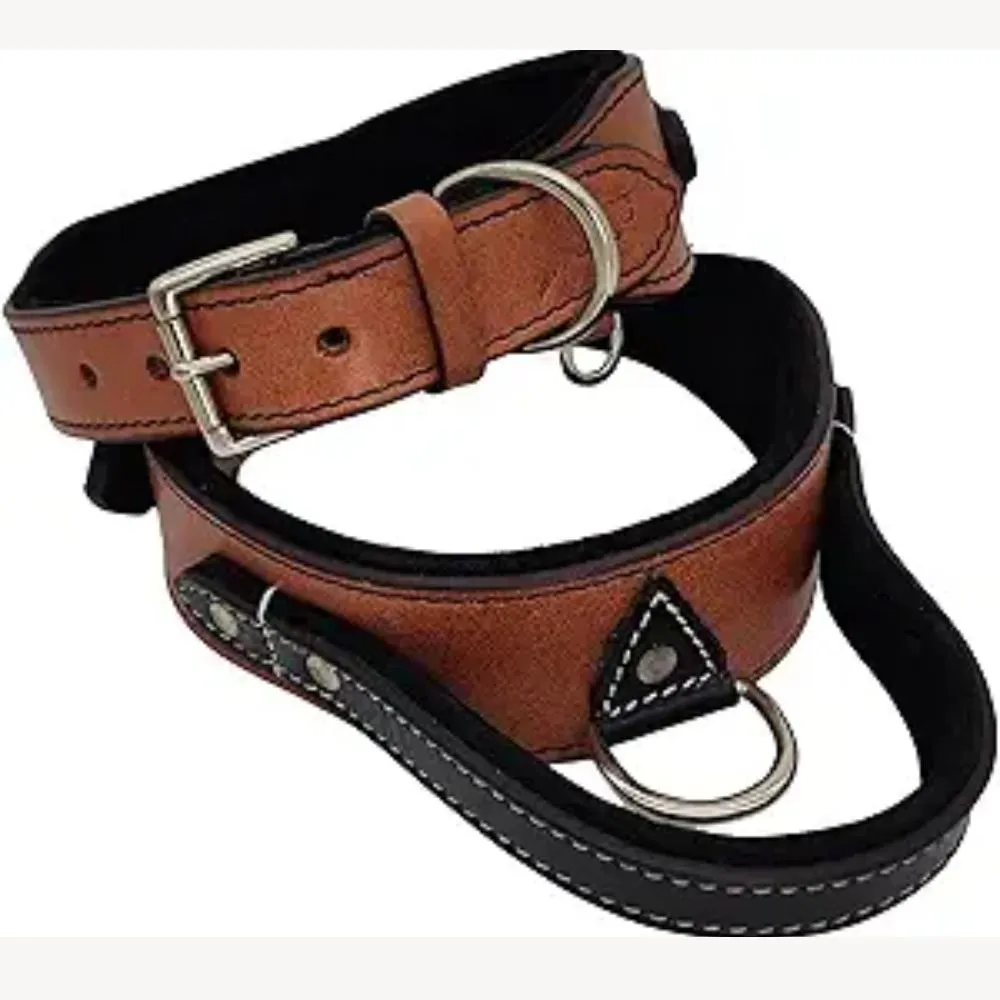
How to Choose the Right Dog Collar for Large Dog Breeds
Selecting the appropriate collar requires evaluating several factors specific to your dog’s individual needs and characteristics.
Size and Fit Guidelines
Proper fit is non-negotiable for large dog safety and comfort. Measure your dog’s neck circumference at its widest point using a flexible measuring tape, then add 2-3 inches to determine collar length.
Sizing by Breed (Approximate):
- Medium-Large (50-70 lbs) – Labs, Boxers, Bulldogs: 18-22 inch collars, 1-1.25 inch width
- Large (70-90 lbs) – German Shepherds, Golden Retrievers, Rottweilers: 20-24 inch collars, 1.25-1.5 inch width
- Extra Large (90+ lbs) – Great Danes, Mastiffs, Saint Bernards: 22-28 inch collars, 1.5-2 inch width
The “two-finger rule” applies: you should comfortably fit two fingers between the collar and your dog’s neck. Tighter risks choking and injury; looser risks your dog slipping out.
Material Considerations
Leather: Premium full-grain leather offers unmatched durability for large dogs while developing a beautiful patina over time. Leather collars should be at least 3-4mm thick for large breeds, with double or triple stitching throughout.
Nylon: Heavy-duty nylon webbing provides excellent strength-to-weight ratio at a lower cost than leather. Look for military-grade nylon with reinforced stitching. Many nylon collars offer waterproof benefits for dogs who swim or play in water frequently.
Biothane: This coated webbing combines nylon’s strength with leather’s appearance while being completely waterproof and odor-resistant. It’s ideal for large dogs who love muddy adventures or swimming.
Chain: Generally not recommended for large dogs as everyday collars. Heavy chains can damage coats, cause injury if caught on objects, and don’t provide appropriate comfort for regular wear.
Strength and Hardware Quality
Large dogs demand collars built to withstand significant force. Examine these quality indicators:
Stitching: Box-and-cross stitch patterns at stress points indicate quality construction. All stitching should be tight, even, and reinforced.
D-Rings and Buckles: Hardware should be forged or cast metal—never thin stamped metal that can bend or break. Stainless steel or brass resists rust and corrosion. Weight capacity ratings should exceed your dog’s weight by at least 50%.
Breaking Strength: While manufacturers don’t always publish this specification, quality collars for large dogs should have breaking strengths of 400-1000+ pounds depending on your dog’s size and strength.
Breed-Specific Considerations
Different large breeds have unique anatomical features affecting collar selection:
Brachycephalic Breeds (Bulldogs, Mastiffs): These dogs have shorter snouts and can experience breathing difficulties. Harnesses often work better than collars, but if using a collar, choose wider designs that sit lower on the neck, away from the throat.
Deep-Chested Breeds (Great Danes, Greyhounds, Dobermans): These dogs risk bloat and are more susceptible to tracheal injury. Martingale collars or harnesses distribute pressure more safely than standard flat collars.
Heavy-Coated Breeds (Newfoundlands, Bernese Mountain Dogs): Thick coats require collars with adequate length to penetrate the fur, ensuring proper fit and tag visibility. Rust-resistant hardware is essential as moisture can accumulate in dense coats.
Working Breeds (German Shepherds, Rottweilers): Strong, intelligent working dogs benefit from durable everyday collars plus specialized training collars for off-leash work and advanced obedience training.
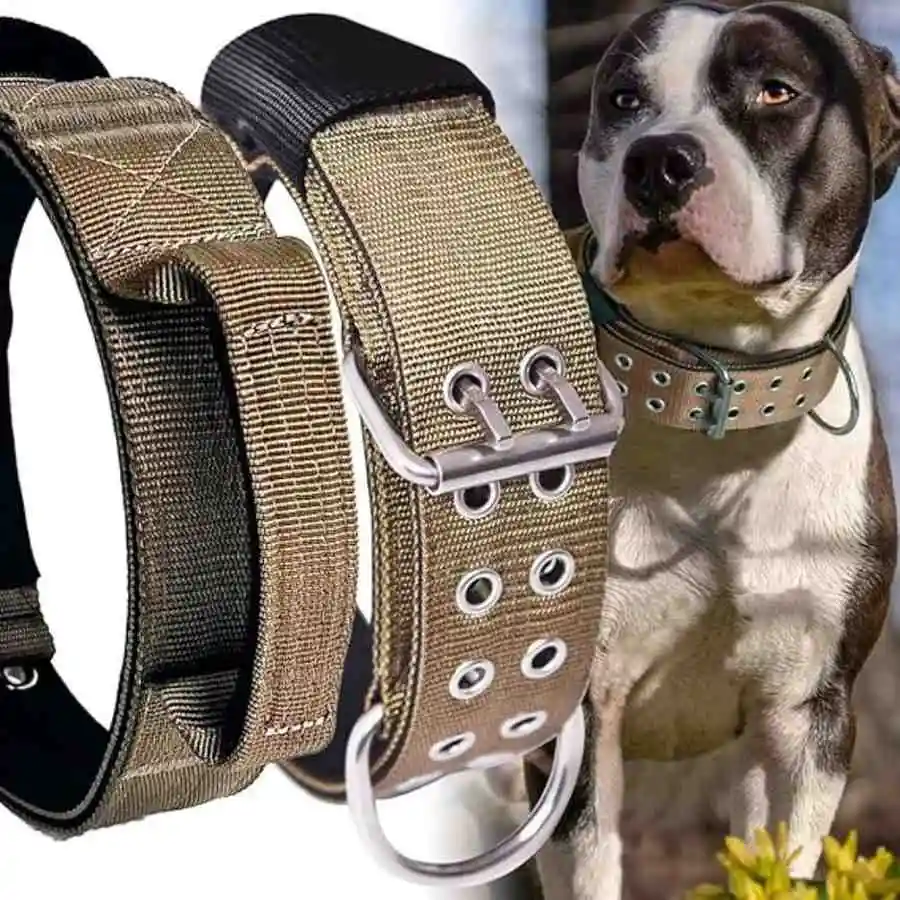
Safety Features Every Large Dog Collar Should Have
Beyond basic functionality, certain safety features protect your large dog during daily activities.
Reflective Elements
Large dogs walking during dawn, dusk, or nighttime need maximum visibility to prevent accidents. Look for:
- 360-degree reflective stitching that catches light from all angles
- Reflective strips at least 1/2 inch wide
- High-visibility color options in neon yellow, orange, or lime green
ID Tag Attachment
Secure ID tag attachment rings should be welded closed and large enough to accommodate multiple tags without overcrowding. Consider:
- Collars with built-in nameplate pockets that hold flat identification tags
- Embroidered collars with contact information stitched directly into the material
- Heavy-duty split rings that won’t open accidentally
Quick-Release Mechanisms
While secure closure is important, some situations require rapid collar removal. Quick-release buckles rated for large dogs provide security during normal wear but release under extreme pressure, preventing strangulation if your dog’s collar catches on objects.
Training Tips: Using Collars Effectively with Large Dogs
Even the best collar won’t solve behavioral issues without proper training techniques.
Loose-Leash Walking
Teaching your large dog to walk politely on leash is essential for everyone’s safety and enjoyment:
- Start with proper equipment: A well-fitted flat collar or martingale for dogs who pull moderately, or a front-clip harness for strong pullers
- Use high-value rewards: Large dogs need motivation that competes with environmental distractions
- Practice the “be a tree” method: When your dog pulls, stop walking immediately and wait for slack in the leash before continuing
- Keep training sessions short: Multiple 10-15 minute sessions work better than lengthy frustrating walks
- Consider professional help: A certified dog trainer experienced with large breeds can address persistent pulling issues
Proper Use of Training Collars for Large Dogs
If incorporating specialized training collars for large dogs:
- Never leave training collars on unsupervised dogs: Remove them immediately after training sessions
- Combine with positive reinforcement: Training collars should communicate, not punish
- Use the minimum effective level: Start with the gentlest correction that produces results
- Focus on teaching, not correcting: Your goal is to teach your dog what TO do, not just what not to do
- Consult professionals: Work with certified trainers who use balanced training methods humanely
Collar Care and Maintenance for Longevity
Quality collars for large dogs represent a significant investment. Proper care extends their lifespan while keeping them safe and hygienic.
Cleaning Guidelines
Leather Collars:
- Wipe down weekly with a damp cloth to remove dirt and oils
- Condition monthly with leather conditioner to prevent drying and cracking
- Allow to air dry completely if wet before putting back on your dog
- Replace when leather shows significant wear, cracking, or weak spots
Nylon and Biothane Collars:
- Hand wash weekly with mild soap and warm water
- Scrub stubborn dirt with a soft brush
- Machine wash in a mesh laundry bag on gentle cycle if heavily soiled
- Air dry completely before use
- Inspect regularly for fraying or damaged stitching
Metal Components:
- Check regularly for rust, corrosion, or sharp edges
- Clean with metal polish if tarnishing occurs
- Replace collars with damaged hardware immediately
Regular Inspections
Every week, examine your large dog’s collar for:
- Fraying fabric or cracking leather
- Loose stitching at stress points
- Bent, cracked, or corroded hardware
- Proper fit (dogs can gain or lose weight)
- Signs of wear that indicate replacement is needed
Never compromise on collar safety—when in doubt, replace it.
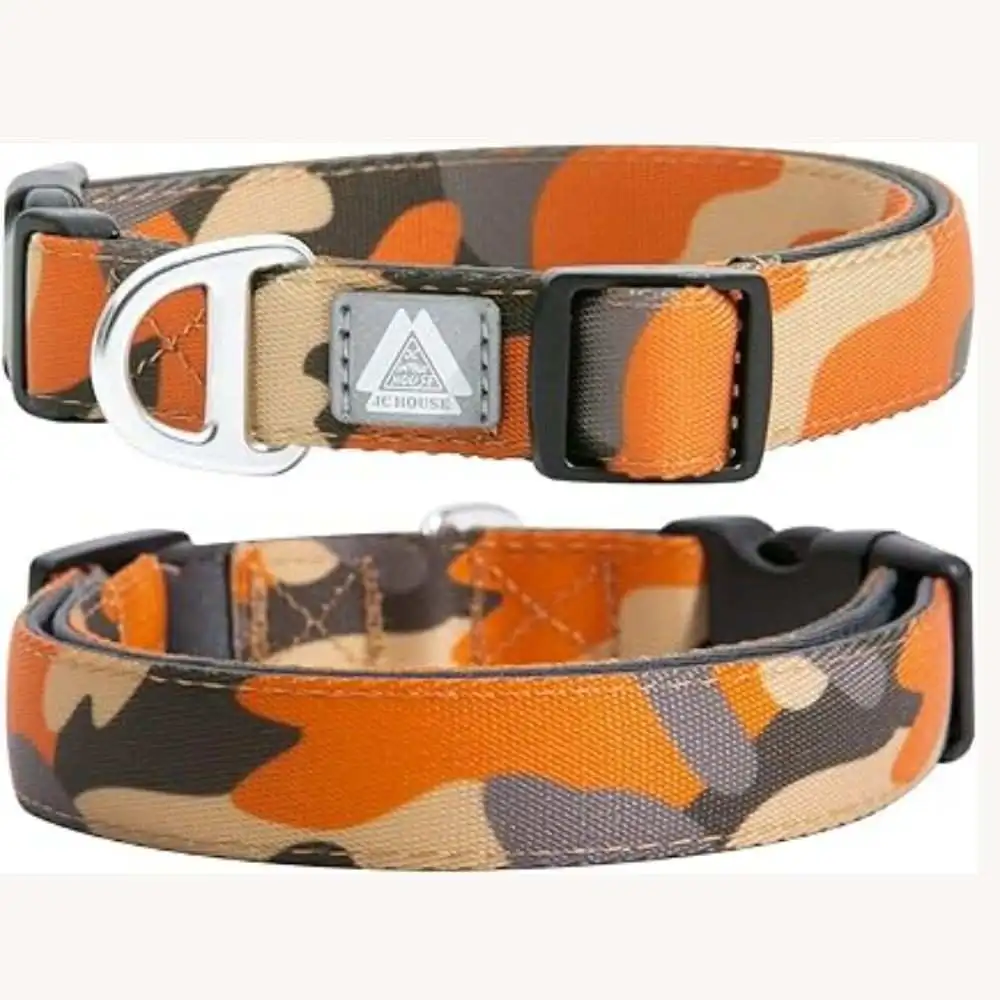
Common Mistakes to Avoid
Even experienced large dog owners sometimes make these collar-related errors:
Sizing Errors
Using collars designed for smaller dogs, even if the length fits, puts your large dog at risk. Narrow collars concentrate pressure dangerously, while inadequate hardware may fail under stress.
Leaving Training Collars On
Prong collars, electronic collars, and even martingales should be removed when not actively training or walking. These specialized tools can cause injury during play or if caught on objects.
Ignoring Signs of Discomfort
Watch for:
- Excessive scratching at the collar area
- Hair loss or irritation on the neck
- Coughing or gagging during walks
- Resistance to wearing the collar
These signs indicate fit problems or allergic reactions requiring immediate attention.
Using Retractable Leashes with Standard Collars
The sudden jerks from retractable leashes can cause serious neck injuries when attached to collars. For large dogs on retractable leashes, harnesses provide safer options.
FAQs About Dog Collars for Large Dogs
What size collar does a large dog need?
Large dogs typically need collars between 18-28 inches in length, depending on breed and individual size. Measure your dog’s neck at its widest point and add 2-3 inches. The collar should allow you to comfortably fit two fingers between it and your dog’s neck. Width is equally important—large dogs need collars at least 1 to 1.5 inches wide to distribute pressure safely.
Are bark collars safe for large dogs?
When used correctly, modern bark collars are safe for large dogs. Choose collars with adjustable sensitivity specifically designed for large breeds, as their deeper bark frequency requires different sensors than small dog collars. Start with the lowest correction setting and never use bark collars as a substitute for addressing the underlying cause of excessive barking through training and environmental management.
What’s the best collar for a dog that pulls?
For large dogs who pull, martingale collars provide gentle control without choking, while front-clip harnesses offer maximum control by redirecting pulling motion. Training collars for large dogs, including head halters, can also be effective when introduced properly. The best choice depends on your dog’s specific pulling behavior and sensitivity level, but should always be combined with positive loose-leash walking training.
How long should large dogs wear Elizabethan collars?
Large dogs should wear Elizabethan collars for the complete healing period recommended by your veterinarian, typically 10-14 days after surgery. The best elizabethan collar for large dogs should remain on 24/7 during recovery, though you may remove it briefly during supervised meals if your dog struggles to eat. Never remove it based on your dog’s comfort alone—premature removal can lead to wound complications requiring additional surgery.
Should I use a collar or harness for my large dog?
Both collars and harnesses have appropriate uses for large dogs. Use collars for holding ID tags and for well-trained dogs who walk calmly on leash. Switch to harnesses for dogs who pull excessively, have respiratory issues, tracheal problems, or neck injuries. Many large dog owners keep both—a flat collar for identification worn daily, plus a harness specifically for walks.
How often should I replace my large dog’s collar?
Replace your large dog’s collar immediately if you notice any damage, fraying, cracked leather, or weakened hardware. Even without visible damage, heavy daily use degrades materials over time. Plan to replace nylon collars every 12-18 months and leather collars every 2-3 years with proper maintenance, though replacement timing varies based on your dog’s activity level and the collar’s construction quality.
Conclusion: Finding Your Large Dog’s Perfect Collar
Selecting the right dog collar for large dog breeds combines practical safety considerations with addressing your specific dog’s behavioral needs and lifestyle. Whether you need a heavy-duty everyday collar, specialized training collars for large dogs, a bark collar for large dogs, or the best elizabethan collar for large dogs during recovery, the perfect collar balances durability, comfort, and functionality.
Remember that your large dog’s collar serves as both a safety device and a training tool. Invest in quality construction that can withstand your dog’s strength, ensure proper fit for their comfort and safety, and replace collars showing any signs of wear. Combine the right collar with consistent positive training methods to help your gentle giant become a well-mannered companion you can confidently take anywhere.
Your large dog depends on you to make informed choices about their gear. With the information in this comprehensive guide, you’re now equipped to select collars that keep your big furry friend safe, comfortable, and happy throughout all your adventures together.
